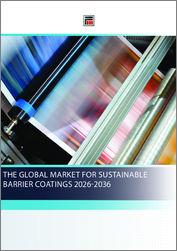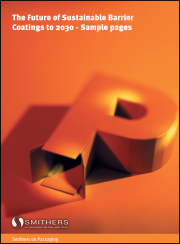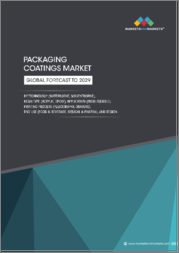
|
시장보고서
상품코드
1757082
세계의 지속가능 배리어 코팅 시장(2026-2036년)The Global Market for Sustainable Barrier Coatings 2026-2036 |
||||||
지속가능한 배리어 코팅 시장은 세계 포장 산업에서 가장 역동적인 분야 중 하나이며, 규제 의무화, 소비자 수요, 전례 없는 기술 혁신의 집중에 의해 주도되고 있습니다. 이 시장은 2036년까지 안정적인 성장세를 보일 것으로 예상되며, 이는 환경 친화적인 포장 솔루션으로의 근본적인 변화를 반영합니다.
열가소성 폴리머는 지속가능한 폴리머의 가장 큰 카테고리로, 재활용 가능한 고성능 배리어 솔루션에 대한 이 부문의 집중을 잘 보여주고 있습니다. 이러한 성장 궤적은 바이오폴리머 부문에서 특히 두드러집니다. 바이오 고분자 및 천연 고분자 코팅이 사용됨에 따라 시장의 진화는 포장의 밸류체인을 근본적으로 재구성하고 있습니다. 이러한 변화는 모든 기판 용도에서 뚜렷하게 나타나고 있으며, 판지, 액체용 판지, 골판지 포장재가 채택률을 주도하고 있는 반면, 경질 플라스틱과 연질 플라스틱 용도는 강력한 성장 잠재력을 보여주고 있습니다.
규제 촉진요인이 시장 확대의 중요한 기반이 되고 있으며, 유럽연합(EU)의 노력은 전 세계 지속가능성 의무화를 주도하고 있습니다. 퍼플루오로알킬물질(PFAS)과 폴리플루오로알킬물질(PFAS)의 단계적 퇴출은 기존의 불소계 화학물질 기반 장벽이 전체 식품 접촉 용도에서 퇴출을 앞두고 있는 상황에서 큰 대체 기회를 창출하고 있습니다. 동시에, 확대된 생산자책임재활용(EPR) 제도와 순환경제 규제는 포장 제조업체들이 재활용 및 퇴비화 가능한 코팅 솔루션을 채택하도록 장려하고 있습니다. 기술 상황을 보면 대부분의 용도에서 생분해성보다 재활용 가능성이 분명히 우선순위를 차지하고 있으며, 이는 인프라 현실과 경제적 고려 사항을 반영합니다. 폴리 비닐 알코올(PVOH) 및 에틸렌 비닐 알코올(EVOH)을 포함한 고급 수성 고분자 용액은 전통적인 석유 기반 장벽을 대체하기 위해 상업적 모멘텀을 얻고 있습니다. 동시에 폴리유산(PLA)과 폴리하이드록시알카노에이트(PHA)와 같은 새로운 바이오 기술도 연구 단계에서 상업화 단계에 접어들고 있습니다.
시장 역학은 지역별로 뚜렷한 차이를 보이고 있으며, 유럽이 규제에 의한 채택을 주도하고, 북미는 주정부 차원의 노력으로 그 뒤를 잇고 있으며, 아시아태평양은 제조 능력과 소비자 선호도의 진화로 인해 중요한 성장 기회로 부상하고 있습니다. 이 부문은 연구개발에 대한 막대한 투자로 혜택을 받고 있으며, 주요 화학 기업, 임산물 제조업체, 전문 기술 프로바이더들이 차세대 코팅 솔루션에서 우위를 점하기 위해 경쟁하고 있습니다. 지속가능한 대체 기술은 일반적으로 기존 코팅보다 20-40%의 추가 비용을 요구하므로 비용 경쟁력은 여전히 중요한 성공 요인입니다. 그러나 규모의 경제 개선, 기술 발전, 규제 준수 요구로 인해 이 격차는 점차 줄어들고 있습니다. 시장은 2030년까지 100% 재활용 가능한 포장을 실현하겠다는 기업의 약속과 친환경 제품에 대한 소비자의 지불 의지와 같은 보다 광범위한 지속가능성 동향과 강한 일치를 보이고 있습니다.
세계의 지속가능 배리어 코팅 시장에 대해 조사분석했으며, 시장 규모와 예측, 기술 상황과 혁신 파이프라인, 규제 환경과 컴플라이언스 전략, 기업 62사의 개요 등의 정보를 제공하고 있습니다.
목차
제1장 개요
- EOL : 재활용 vs. 생분해성
- 시장의 정의와 분류
- 세계 시장 규모와 예측
- 주요 시장 촉진요인과 동향
- 시장이 해결해야 할 과제, 억제요인
- 시장 기회
- 전략적 시나리오와 시장의 진화
- 시장의 소비와 예측
- 신기술과 혁신
제2장 기술 상황과 혁신 파이프라인
- 기재 : 종이와 플라스틱
- 압출 배리어 코팅
- 열가소성 폴리머
- 알루미늄
- 왁스
- 실리콘과 기타 천연 재료
- 고차단성 폴리머
- 습식 배리어 코팅
- 왁스 코팅
- 배리어 메탈라이제이션
- 생분해성, 바이오 기반, 재활용 가능한 코팅
- 단층 코팅
- 현재 최첨단 기술
- 기술 성능 벤치마킹
제3장 규제 환경과 컴플라이언스
- 세계의 규제 구조
- 지역의 규제의 분석
- 컴플라이언스 전략과 업계의 대응
제4장 밸류체인 분석
- 원재료 공급망
- 제조와 생산
- 최종 용도와 시장
제5장 용도 시장과 최종 용도 분석
- 식품 포장 용도
- 음료 포장
- 식품 이외 용도
- 특정 기재 분석
제6장 지역 시장
- 유럽 시장 분석
- 북미 시장 분석
- 아시아태평양 시장 분석
- 기타 지역 시장
제7장 기업 개요(기업 62사의 개요)
제8장 부록
제9장 참고 문헌
KSA 25.07.08The sustainable barrier coatings market represents one of the most dynamic segments within the global packaging industry, driven by an unprecedented convergence of regulatory mandates, consumer demand, and technological innovation. The global sustainable barriers market demonstrates steady growth to 2036, reflecting the industry's fundamental shift toward environmentally responsible packaging solutions.
Thermoplastic polymers are the largest category of sustainable polymers, highlighting the sector's focus on recyclable and high-performance barrier solutions. This growth trajectory is particularly pronounced in the bio-based polymer segment. The market's evolution is fundamentally reshaping the packaging value chain, as bio-based and natural polymer coatings is growing in use. This transformation is evident across substrate applications, with cartonboard, liquid paperboard, and corrugated packaging leading adoption rates, while rigid and flexible plastic applications show strong growth potential.
Regulatory drivers form a critical foundation for market expansion, with European Union initiatives leading global sustainability mandates. The phase-out of per- and polyfluoroalkyl substances (PFAS) creates significant displacement opportunities, as traditional fluorochemical-based barriers face elimination across food contact applications. Simultaneously, Extended Producer Responsibility (EPR) schemes and circular economy regulations incentivize packaging manufacturers to adopt recyclable and compostable coating solutions. The technology landscape reveals a clear preference for recyclability over biodegradability in most applications, reflecting infrastructure realities and economic considerations. Advanced aqueous polymeric solutions, including polyvinyl alcohol (PVOH) and ethylene vinyl alcohol (EVOH), are gaining commercial traction as direct replacements for traditional petroleum-based barriers. Concurrently, emerging bio-based technologies such as polylactic acid (PLA) and polyhydroxyalkanoates (PHA) are transitioning from research to commercial implementation.
Market dynamics show distinct regional variations, with Europe leading regulatory-driven adoption, North America following with state-level initiatives, and Asia-Pacific emerging as a significant growth opportunity driven by manufacturing capacity and evolving consumer preferences. The sector benefits from substantial investment in research and development, with leading chemical companies, forest products manufacturers, and specialized technology providers competing to establish dominant positions in next-generation coating solutions. Cost competitiveness remains a critical success factor, as sustainable alternatives typically command price premiums of 20-40% over conventional coatings. However, improving economies of scale, technological advancement, and regulatory compliance requirements are progressively narrowing this gap. The market demonstrates strong alignment with broader sustainability trends, including corporate commitments to achieve 100% recyclable packaging by 2030 and consumer willingness to pay premiums for environmentally responsible products.
"The Global Market for Sustainable Barrier Coatings 2026-2036" provides strategic insights into a rapidly evolving market projected to reach significant growth through 2036.
Report contents include:
- Market Analysis & Forecasting
- Comprehensive Market Sizing: Global market value and volume analysis spanning 2019-2036 with detailed regional breakdowns across Europe, North America, Asia-Pacific, and Rest of World markets
- Technology Segment Forecasts: In-depth analysis of thermoplastic polymers, high barrier coatings, aluminium, waxes, silicone materials, and bio-based/biodegradable coatings consumption patterns
- End-Use Application Analysis: Detailed market consumption data for food packaging, drinks packaging, and non-food applications including pharmaceutical, industrial, and e-commerce packaging
- Substrate-Specific Market Evolution: Comprehensive analysis of cartonboard, corrugated, flexible plastic, and rigid plastic barrier applications with growth projections through 2036
- Strategic Scenario Planning: Base case, accelerated sustainability, regulatory disruption, and technology breakthrough scenarios with market impact assessment
- Technology Landscape & Innovation Pipeline
- Advanced Coating Technologies: Detailed analysis of extrusion barrier coatings, wet-barrier coatings, wax coating processes, and barrier metallisation technologies
- Bio-based Polymer Solutions: Comprehensive coverage of polysaccharides, PLA, polybutylene succinate, polyhydroxyalkanoates (PHA), alginate, cellulose acetate, protein-based systems, bio-PE, bio-PET, lignin-based polymers, bacterial cellulose, furan-based polymers (PEF), and tannin-based polymers
- Nanomaterial Innovations: Extensive analysis of nanoclays, nanocellulose, graphene oxide, carbon nanotubes (CNT), and halloysite nanotubes applications
- Water-Based Coating Systems: Technology performance benchmarking, processing requirements, and market adoption patterns
- Dispersion Coating Technologies: Application methods, performance optimization, and environmental impact assessment
- Performance Benchmarking: Barrier property comparisons for oxygen, moisture, and grease resistance; heat resistance and processing temperature requirements; recyclability and compostability performance analysis
- Regulatory Environment & Compliance Strategy
- Global PFAS Phase-Out Analysis: Comprehensive timeline and impact assessment of PFAS restrictions across major markets
- EU Regulatory Framework: Detailed analysis of Packaging and Packaging Waste Regulation (PPWR), Single Use Plastics Directive (SUPD), REACH requirements, and circular economy action plans
- North American Compliance: FDA food contact regulations, state-level PFAS bans, and environmental protection initiatives
- Asia-Pacific Regulatory Trends: Emerging market regulatory developments and compliance requirements
- Industry Response Strategies: EUROPEN and 4evergreen consortium initiatives, collaborative compliance frameworks, certification protocols, and supply chain management
- Value Chain & Market Dynamics
- Raw Material Supply Analysis: Bio-based feedstock availability, specialty chemical markets, supply chain risk assessment, and vertical integration strategies
- Manufacturing & Production: Coating production technologies, quality control challenges, scale economics, and cost optimization strategies
- End-Use Market Requirements: Packaging converter specifications, brand owner preferences, performance validation protocols, and market adoption patterns
- Economic Analysis: Cost structure analysis by coating type, price trend analysis, and cost-performance trade-off evaluation
- Application Markets & End-Use Analysis
- Food Packaging Applications: Fresh food, processed food, frozen food, and convenience food packaging requirements with market consumption forecasts
- Beverage Packaging: Liquid paperboard coating requirements, coffee cup applications, alcohol packaging, and specialty beverage needs
- Non-Food Applications: Pharmaceutical packaging, industrial applications, consumer goods, flexible electronics, e-commerce solutions, and thermal barrier coatings
- Substrate Applications: Detailed analysis of cartonboard, corrugated, flexible plastic, and rigid plastic substrate solutions
- Regional Market Analysis
- Europe Market Analysis: Market size projections, regulatory impact assessment, technology adoption patterns, and competitive landscape
- North America Market: United States and Canada market dynamics, regulatory environment, and growth opportunities
- Asia-Pacific Market: Regional growth drivers, manufacturing capacity, technology transfer, and emerging opportunities
- Rest of World Markets: Latin America, Middle East, and Africa market development potential and entry strategies
- Comprehensive Company Profiles
- 62 Company Profiles: Detailed analysis of leading market participants including technology portfolios, market positioning, strategic initiatives, and competitive advantages. Companies profiled include Actega, Ahlstrom, ANPOLY, Aquapak Polymers Ltd, Aquaspersions, Archipelago Technology Group, Archroma, BASF SE, Borregaard Chemcell, Braskem, Brightplus Oy, Cellugy, Constantia Flexibles, Cosmo Specialty Chemicals, Danimer Scientific, Dow Chemical Company, DuPont de Nemours, Earthodic, FlexSea, Follmann GmbH & Co. KG, Greif, Holmen Iggesund, IonKraft GmbH, J&J Green Paper, Kagzi Bottles Private Limited, Kelpi, Kemira Oyj, KHS Group, Kuraray, Lactips, Mantrose-Haeuser, Melodea Ltd., Michelman Inc., Mi Terro Inc., Mondi Group, Nabaco Inc., Nagase America, Nfinite Nanotech, Nippon Paper Industries, Notpla, Oji Paper Company, Omya, one - five, and more.....
TABLE OF CONTENTS
1. EXECUTIVE SUMMARY
- 1.1. End of life: recycling vs biodegradability
- 1.1.1. Circular economy principles and packaging design
- 1.1.2. Biodegradability standards and certification requirements
- 1.1.3. Market preference evolution and brand positioning
- 1.1.4. Economic analysis of end-of-life options
- 1.2. Market Definitions and Classifications
- 1.2.1. Sustainable barrier coatings taxonomy
- 1.2.2. Performance criteria and sustainability metrics
- 1.2.3. Regulatory compliance standards
- 1.3. Global Market Size and Forecast
- 1.3.1. Market value and volume analysis (2019-2035)
- 1.3.2. Regional market breakdown and growth trajectories
- 1.3.3. End use markets and applications
- 1.3.4. Price trend analysis and cost structure
- 1.4. Key Market Drivers and Trends
- 1.4.1. Regulatory mandates and PFAS phase-out impact
- 1.4.2. Circular economy initiatives and recyclability requirements
- 1.4.3. Consumer demand for sustainable packaging
- 1.4.4. E-commerce growth and packaging performance needs
- 1.4.5. Brand owner sustainability commitments
- 1.5. Market Challenges and Restraints
- 1.5.1. Performance limitations of sustainable alternatives
- 1.5.2. Cost premiums and economic viability
- 1.5.3. Supply chain constraints for bio-based materials
- 1.5.4. Technical complexity and application challenges
- 1.5.5. Recycling infrastructure limitations
- 1.6. Market Opportunities
- 1.6.1. PFAS replacement market opportunity
- 1.6.2. Adjacent market expansion potential
- 1.6.3. Geographic expansion in emerging markets
- 1.6.4. Value-added service opportunities
- 1.7. Strategic Scenarios and Market Evolution
- 1.7.1. Base case market evolution (2025-2036)
- 1.7.2. Accelerated sustainability scenario
- 1.7.3. Regulatory disruption scenario
- 1.7.4. Technology breakthrough scenario
- 1.8. Market Consumption and Forecasts
- 1.8.1. Material Type
- 1.8.1.1. Thermoplastic polymers
- 1.8.1.2. High barrier coatings
- 1.8.1.3. Aluminium
- 1.8.1.4. Waxes
- 1.8.1.5. Silicone and other natural materials
- 1.8.1.6. Biobased and biodegradable coatings
- 1.8.2. Substrate Type
- 1.8.3. Region
- 1.8.4. High-barrier coating evolution
- 1.8.5. Application Market Forecasts
- 1.8.5.1. End-use segment growth projections
- 1.8.5.2. Substrate-specific market evolution
- 1.8.5.3. Performance tier market development
- 1.8.5.4. Premium vs. commodity segment analysis
- 1.8.1. Material Type
- 1.9. Emerging Technologies and Innovations
- 1.9.1. Advanced aqueous polymeric solutions (PVOH, EVOH)
- 1.9.2. Next-generation bio-polymers
- 1.9.3. Nano-cellulose and natural fiber composites
- 1.9.4. Seaweed-based biopolymer coatings
- 1.9.5. Smart and functional coating systems
2. TECHNOLOGY LANDSCAPE AND INNOVATION PIPELINE
- 2.1. Substrates: Paper and Plastic
- 2.1.1. Paper substrate characteristics and coating requirements
- 2.1.2. Plastic substrate applications and sustainability challenges
- 2.1.3. Substrate selection criteria and performance trade-offs
- 2.2. Extrusion Barrier Coatings
- 2.3. Thermoplastic Polymers
- 2.4. Aluminium
- 2.5. Waxes
- 2.6. Silicone and Other Natural Materials
- 2.7. High Barrier Polymers
- 2.8. Wet-Barrier Coatings
- 2.8.1. Application methods and process optimization
- 2.8.2. Performance benchmarking against alternatives
- 2.8.3. Environmental impact assessment
- 2.8.4. Market adoption patterns
- 2.9. Wax Coating
- 2.10. Barrier Metallisation
- 2.10.1. Technology overview and application scope
- 2.10.2. Performance advantages in barrier applications
- 2.10.3. Sustainability challenges and recycling impact
- 2.11. Biodegradable, biobased and recyclable coatings
- 2.12. Monolayer Coatings
- 2.13. Current Technology State-of-the-Art
- 2.13.1. Water-based coating technologies
- 2.13.2. Bio-based polymer solutions
- 2.13.2.1. Polysaccharides
- 2.13.2.2. Poly(lactic acid) (PLA)
- 2.13.2.3. Poly(butylene Succinate
- 2.13.2.4. Polyhydroxyalkanoates (PHA)
- 2.13.2.5. Alginate
- 2.13.2.6. Cellulose Acetate
- 2.13.2.7. Protein-Based (Soy, Wheat)
- 2.13.2.8. Bio-PE (Polyethylene)
- 2.13.2.9. Bio-PET
- 2.13.2.10. Lignin-Based Polymers
- 2.13.2.11. Bacterial Cellulose
- 2.13.2.12. Furan-Based Polymers (PEF)
- 2.13.2.13. Tannin-Based Polymers
- 2.13.3. Dispersion Coating Systems
- 2.13.4. Nano-enhanced Barrier Materials
- 2.13.4.1. Nanoclays
- 2.13.4.2. Nanocellulose
- 2.13.4.3. Graphene Oxide
- 2.13.4.4. Carbon Nanotubes (CNT)
- 2.13.4.5. Halloysite Nanotubes
- 2.13.4.6. Carbon dots
- 2.13.5. Rosins
- 2.14. Technology Performance Benchmarking
- 2.14.1. Barrier property comparisons (oxygen, moisture, grease)
- 2.14.2. Heat resistance and processing temperature requirements
- 2.14.3. Recyclability and compostability performance
- 2.14.4. Cost-performance trade-off analysis
3. REGULATORY ENVIRONMENT AND COMPLIANCE
- 3.1. Global Regulatory Framework
- 3.1.1. PFAS restrictions and phase-out schedules
- 3.1.2. Single-use plastics directives
- 3.1.3. Food contact regulations and safety requirements
- 3.1.4. Extended Producer Responsibility (EPR) schemes
- 3.1.5. PFAS ban
- 3.2. Regional Regulatory Analysis
- 3.2.1. European Union regulatory landscape
- 3.2.1.1. Packaging and Packaging Waste Regulation (PPWR)
- 3.2.1.2. Single Use Plastics Directive (SUPD)
- 3.2.1.3. REACH and chemical safety requirements
- 3.2.1.4. Circular economy action plans
- 3.2.2. North American regulatory environment
- 3.2.2.1. FDA food contact regulations
- 3.2.2.2. State-level PFAS bans and restrictions
- 3.2.2.3. Environmental protection initiatives
- 3.2.3. Asia-Pacific regulatory trends
- 3.2.4. Emerging market regulatory developments
- 3.2.1. European Union regulatory landscape
- 3.3. Compliance Strategies and Industry Response
- 3.3.1. Industry consortium initiatives
- 3.3.2. Collaborative compliance frameworks
- 3.3.3. Certification and testing protocols
- 3.3.4. Supply chain compliance management
4. VALUE CHAIN ANALYSIS
- 4.1. Raw Material Supply Chain
- 4.1.1. Bio-based feedstock availability and sourcing
- 4.1.2. Specialty chemical ingredient markets
- 4.1.3. Supply chain risk assessment
- 4.1.4. Vertical integration strategies
- 4.2. Manufacturing and Production
- 4.2.1. Coating production technologies and processes
- 4.2.2. Quality control and consistency challenges
- 4.2.3. Scale economics and cost optimization
- 4.3. End-Use Applications and Markets
- 4.3.1. Packaging converter requirements
- 4.3.2. Brand owner specifications and preferences
- 4.3.3. Performance validation and testing
- 4.3.4. Market adoption patterns
5. APPLICATIONS MARKETS AND END USE ANALYSIS
- 5.1. Food Packaging Applications
- 5.1.1. Fresh food packaging requirements
- 5.1.2. Processed food barrier needs
- 5.1.3. Frozen food applications
- 5.1.4. Convenience food packaging trends
- 5.1.5. Market consumption
- 5.2. Drinks Packaging
- 5.2.1. Liquid paperboard coating requirements
- 5.2.2. Coffee cup and foodservice applications
- 5.2.3. Alcohol packaging considerations
- 5.2.4. Specialty beverage packaging needs
- 5.2.5. Market consumption
- 5.3. Non-Food Applications
- 5.3.1. Pharmaceutical packaging requirements
- 5.3.2. Industrial packaging applications
- 5.3.3. Consumer goods packaging
- 5.3.4. Flexible electronics packaging
- 5.3.5. E-commerce packaging solutions
- 5.3.6. Thermal barrier coatings
- 5.3.7. Market consumption
- 5.4. Substrate-Specific Analysis
- 5.4.1. Cartonboard coating applications
- 5.4.2. Corrugated packaging solutions
- 5.4.3. Flexible plastic substrate coatings
- 5.4.4. Rigid plastic barrier applications
6. REGIONAL MARKETS
- 6.1. Europe Market Analysis
- 6.2. North America Market Analysis
- 6.3. Asia-Pacific Market Analysis
- 6.4. Rest of World Markets
7. COMPANY PROFILES(62 company profiles)
8. APPENDIX
- 8.1. Research Methodology
- 8.2. Glossary and Terminology
- 8.2.1. Technical Terminology Definitions
- 8.2.2. Industry Acronym Reference



















